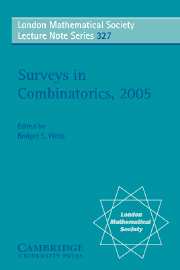Book contents
- Frontmatter
- Contents
- Preface
- 1 Finite field models in additive combinatorics
- 2 The subgroup structure of finite classical groups in terms of geometric configurations
- 3 Constructing combinatorial objects via cliques
- 4 Flocks of circle planes
- 5 Judicious partitions and related problems
- 6 An isoperimetric method for the small sumset problem
- 7 The structure of claw-free graphs
- 8 The multivariate Tutte polynomial (alias Potts model) for graphs and matroids
- 9 The sparse regularity lemma and its applications
4 - Flocks of circle planes
Published online by Cambridge University Press: 04 August 2010
- Frontmatter
- Contents
- Preface
- 1 Finite field models in additive combinatorics
- 2 The subgroup structure of finite classical groups in terms of geometric configurations
- 3 Constructing combinatorial objects via cliques
- 4 Flocks of circle planes
- 5 Judicious partitions and related problems
- 6 An isoperimetric method for the small sumset problem
- 7 The structure of claw-free graphs
- 8 The multivariate Tutte polynomial (alias Potts model) for graphs and matroids
- 9 The sparse regularity lemma and its applications
Summary
Abstract
Flocks of finite circle planes—inversive, Minkowski and Laguerre planes—are surveyed, including their connections with projective planes, generalised quadrangles and ovals.
Circle planes
In the last thirty years, there has been considerable activity in the study of flocks of circle planes, originally by Thas, Walker and Fisher, but later, after Kantor, Payne and Thas had established connections between flocks of Laguerre planes and generalised quadrangles in the 1980s, by many authors. Their importance lies mainly in their connections with projective planes and generalised quadrangles.
The circle planes are the inversive, Minkowski and Laguerre planes, defined below. Their study received impetus when Benz published his book [9] devoted to them in 1973. They are related to ovoids, sharply 3-transitive sets and ovals, respectively.
Inversive planes
An inversive plane, I, is an incidence structure with a finite number of points and circles with the following properties.
(1) Every 3 distinct points are incident with a unique circle.
(2) Every circle has n + 1 > 2 points incident with it.
(3) There are n2 + 1 points.
The integer n is called the order of I.
Example 1.1 The classical inversive plane I(q) has as its points the points of an elliptic quadric E of PG(3, q) and as its circles the non-tangent plane sections of E. It has order q, and automorphism group PΓO−(4, q). See [27] for more on elliptic quadrics. □
- Type
- Chapter
- Information
- Surveys in Combinatorics 2005 , pp. 83 - 94Publisher: Cambridge University PressPrint publication year: 2005



